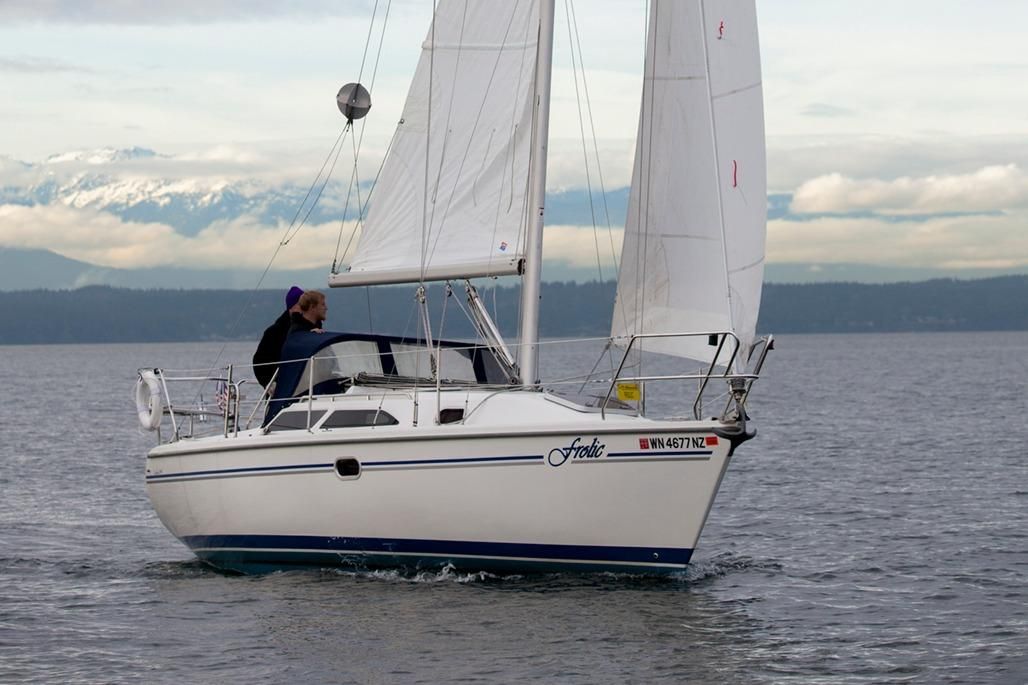While it’s certainly great fun cruising on small boats, there comes a time in many sailors’ lives when they long for the comfort of double berths, hot water, a decent size ice box, standing headroom, and a shower you don’t have to hang in the rigging. The minimum size most manufacturers seem to have determined is capable of accommodating all these creature comforts, in a reasonably attractive package, seems to be 28 feet.
Following Hunter and Pearson’s success with this size cruiser, Catalina introduced their 28-foot model in 1989. In 1995, the hull was widened slightly in the stern in order to maximize accommodations, and the new model became the Catalina 28 Mark II. It remains in Catalina’s 2001 product line.
The look of this design is clean and well proportioned and is the product of Catalina’s in-house design team headed by Gerry Douglas. The overall length of the original model is 28’ 6" and was actually reduced by two inches, to 28’4", for the Mark II model. The waterline length of both models is 23’10", and the maximum beam increased from an original 10’2" to 10’4" for the Mark II model. Two keel configurations were offered, a fin drawing 5’3" and a wing drawing 3’10". Displacement of vessels fitted with the fin keel is 8300 pounds and 8600 pounds for vessels fitted with wing keels.
Before I discuss construction, I’m going to take a moment to define what I mean by "core constructed," because several weeks ago I had a rather frank e-mail from a reader admonishing me for referring to a vessel as being a solid laminate which he, after purchase, discovered was a "cored hull". A commonly accepted definition of a cored composite is one that has a central core material to which faces are adhered to form a sandwich-like composite. In boat construction these cores are usually plywood, balsa wood, various density foams, and various honeycomb materials. There are several natural and synthetic core fabrics, such as Coremat® and Tigercore®, used by boat builders to build up laminate thickness economically; however, the use of such materials is not typically referred to as a cored composite.
That said, the hull of the Catalina 28 is a typical, solid laminate fiberglass composite without any central core. The cabin and decks are mostly cored composites with a balsa wood core. The deck and hull are joined in a shoebox fashion with mechanical fasteners, adhesives, and an external aluminum rub rail with vinyl insert. Fiberglass liners are used extensively for interior components, as well as structure, and additional strength is provided by plywood bulkheads and fiberglass encapsulated stringers. Over the last few years, I have inspected several of these boats, and they seem to be standing up well to routine service. Small cracks in the gel coat surface are common on the decks particularly at tightly radiused corners in the cockpit, and cracking is common along the deck-to-hull joint, usually as a result of hitting pilings and docks while maneuvering. This type of hull-to-deck joint construction is quite vulnerable to damage, and considerable cracking could indicate structural damage or a potential for leaks at the joint.
The deck layout of the Catalina 28 clearly has the look of a bigger boat with its T-shaped cockpit, wheel steering, walk-through transom, and stern boarding platform. The side decks are fairly wide for a 28-footer, and rigging shrouds are inboard against the cabin house to allow easy passage. All sail halyards are led to winches on each side of the companionway, and the mainsheet traveler is mounted forward of the companionway to keep controls out of the cockpit. This is a good compromise arrangement with the drawback being that a single-handed sailor has to leave the helm to adjust the trim of the mainsail.
The interior arrangement of the Catalina 28 also has the look and feel of a larger boat and nearly all the standard accommodations of a 35-footer. The arrangement features a V-berth cabin forward, main saloon with port and starboard settees, and centerline drop-leaf table. To the port side of the companionway there is a head with shower. There is also a navigation table with icebox below. To starboard is the galley with sink and two burner stove. Tucked beneath the cockpit is an athwartships double berth. The berth is slightly larger on the Mark II model and can actually accommodate two adults. Note - I did not say in comfort. Noticeably missing from this design is a cockpit locker for storage of those dirty, nasty items like B-B-Q grill, fenders, dock lines, spare anchor, and cleaning supplies that you just wouldn’t want to lay atop the upholstery below.
Auxiliary power is provided by an 18 hp Universal Marine diesel engine in an engine box beneath the companionway. This provides an excellent horsepower-to-weight ratio for this size boat. Universal Marine engines have good service support and, if properly maintained, should provide years of trouble free operation. Access is good for service and maintenance.
The Catalina 28 is rigged as a masthead sloop with double spreader mast and fore and aft lower shrouds.The sail area-to-displacement ratio of the fin keel model is a modest 14.2, but, with mainsail and 150 genoa, performance is still quite good even in light wind. The inboard position of the shrouds allows for good sheeting angles and good windward performance.
The Catalina 28 has been in production for more than 10 years, and finding used models is usually not difficult. The cost of a Catalina 28 averages nearly 30 percent more than Catalina 27s of similar age. At first glance, this seems a big premium to pay for an extra foot in length, but the 28 includes considerably more standard equipment that makes this boat a comfortable little cruiser. I think most couples and small families will find the Catalina 28 offers comfortable size, and good accommodations, and is affordably priced for weekend or week long cruising adventures.





